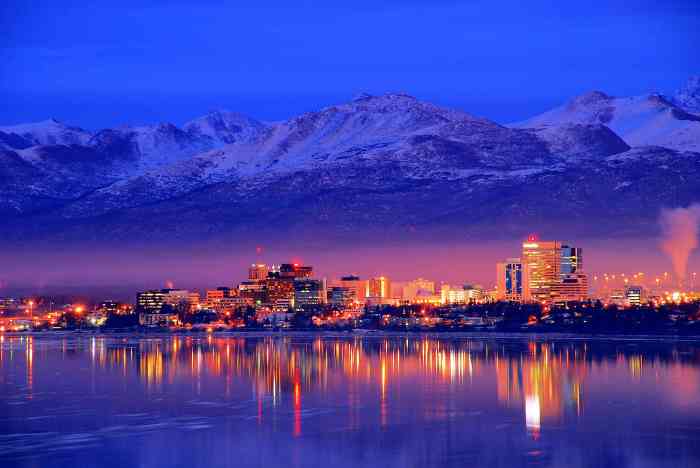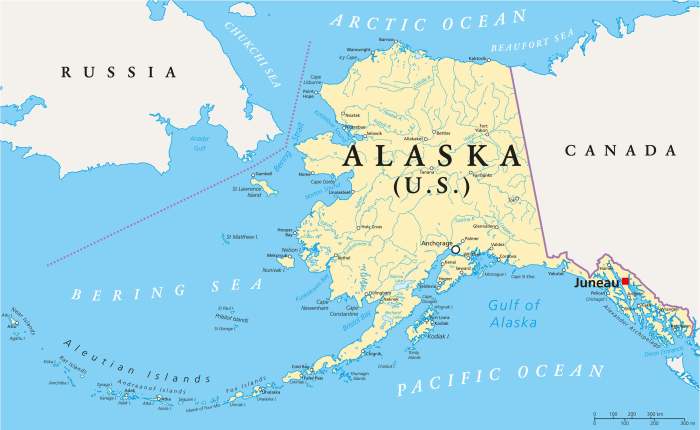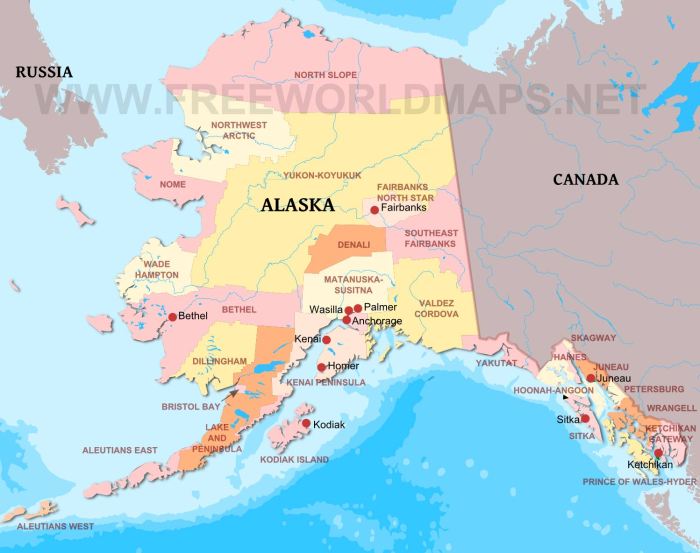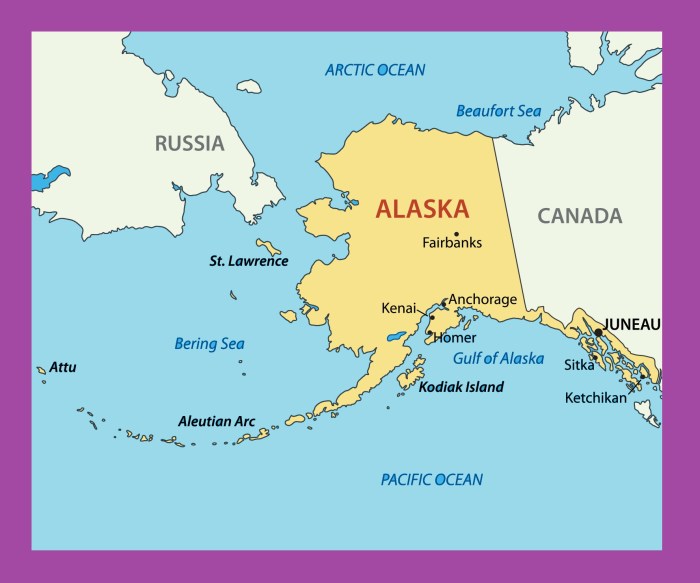AlaskaUSA: Exploring the Last Frontier’s Vastness and Heritage
Alaska, the largest and northernmost state in the United States, captivates with its awe-inspiring natural beauty, rich history, and diverse cultural tapestry. From towering mountain ranges to sprawling glaciers and a coastline that stretches for thousands of miles, Alaska beckons adventurers, nature enthusiasts, and history buffs alike.
Geographic Features

Alaska, the largest state in the United States, boasts a vast and diverse landscape that sets it apart from the rest of the nation. Its immense size, towering mountain ranges, expansive glaciers, and rugged coastline shape its unique character.
The state’s proximity to the Arctic Circle significantly influences its climate and ecosystems. The northernmost region of Alaska experiences polar conditions, with long, cold winters and short, cool summers.
Mountain Ranges, Alaskausa
Alaska is home to some of the most impressive mountain ranges in North America, including the Alaska Range, the Brooks Range, and the Wrangell Mountains. These towering peaks provide a breathtaking backdrop to the state’s vast wilderness.
Alaska is a great place to take a family vacation, but it can be expensive. If you’re on a budget, there are still plenty of ways to have a great time. One way to save money is to look for discounts on activities and attractions.
Another way to save money is to pack your own food and drinks. You can also save money by staying in a budget-friendly hotel or campground. Budget family vacations are a great way to see Alaska without breaking the bank.
There are many different types of budget-friendly activities available, so you’re sure to find something that everyone in your family will enjoy. With a little planning, you can have a wonderful family vacation in Alaska without spending a lot of money.
- Alaska Range: The Alaska Range stretches for over 600 miles across south-central Alaska and includes Denali, the highest peak in North America at 20,310 feet.
- Brooks Range: The Brooks Range forms the northern boundary of Alaska and is known for its rugged terrain and pristine wilderness.
- Wrangell Mountains: The Wrangell Mountains are located in southeastern Alaska and are home to some of the most active volcanoes in the United States.
Glaciers
Alaska is home to an estimated 100,000 glaciers, more than any other state in the United States. These massive rivers of ice play a vital role in shaping the state’s landscape and supporting its ecosystems.
- Glacier Bay National Park: Glacier Bay National Park is home to some of the most accessible glaciers in Alaska, including the massive Margerie Glacier.
- Wrangell-St. Elias National Park: Wrangell-St. Elias National Park is home to the largest subpolar icefield in North America, covering an area of over 13 million acres.
- Denali National Park: Denali National Park is home to the Ruth Glacier, one of the largest glaciers in the Alaska Range.
Coastline
Alaska has the longest coastline of any state in the United States, stretching for over 6,600 miles. This rugged and diverse coastline includes everything from sandy beaches to towering cliffs.
- Inside Passage: The Inside Passage is a protected waterway that runs along the southeastern coast of Alaska, providing a scenic route for boaters and kayakers.
- Gulf of Alaska: The Gulf of Alaska is a vast body of water that lies to the south of Alaska and is home to a variety of marine life, including whales, sea lions, and salmon.
- Bering Sea: The Bering Sea is a marginal sea of the Pacific Ocean that lies to the west of Alaska and is known for its rich fisheries.
Natural Resources: Alaskausa

Alaska possesses an abundance of natural resources that have significantly shaped its economy and infrastructure. These resources include oil, gas, minerals, and timber, each playing a vital role in the state’s development.
The discovery of oil in the Prudhoe Bay field in 1968 marked a turning point for Alaska. The subsequent construction of the Trans-Alaska Pipeline System (TAPS) enabled the transportation of oil from the North Slope to Valdez, creating a major revenue stream for the state.
Oil and Gas
- Alaska is the largest oil-producing state in the United States, accounting for approximately 15% of domestic production.
- The North Slope of Alaska holds vast reserves of oil and gas, with Prudhoe Bay being the largest oil field in North America.
- The Trans-Alaska Pipeline System (TAPS) is a 800-mile (1,287 km) pipeline that transports oil from the North Slope to Valdez, where it is loaded onto tankers for shipment.
Minerals
- Alaska is rich in minerals, including gold, silver, copper, lead, zinc, and coal.
- The Red Dog Mine in Northwest Alaska is one of the world’s largest zinc mines.
- The Pebble Mine project in Southwest Alaska has the potential to be one of the largest copper and gold mines in the world.
Timber
- Alaska has vast forests, primarily consisting of spruce, hemlock, and pine.
- The timber industry plays a significant role in the state’s economy, providing jobs and supporting local communities.
- Alaska’s forests are managed sustainably to ensure their long-term health and productivity.
Climate and Environment

Alaska’s vast expanse encompasses diverse climate zones, from the frigid Arctic tundra in the north to the temperate rainforest in the southeast. The state’s climate is influenced by its proximity to the Arctic Ocean, the Pacific Ocean, and the towering mountain ranges that crisscross its interior.
The Arctic tundra, located in the northernmost part of the state, experiences long, cold winters and short, cool summers. The average temperature in January, the coldest month, is -20°F (-29°C), while the average temperature in July, the warmest month, is 45°F (7°C). Precipitation is low, with an average annual snowfall of 10 inches (25 cm).
South of the Arctic tundra lies the subarctic climate zone, which covers much of the interior of Alaska. Winters in this zone are cold and long, with average temperatures in January ranging from -10°F (-23°C) to 0°F (-18°C). Summers are short and warm, with average temperatures in July ranging from 55°F (13°C) to 65°F (18°C). Precipitation is moderate, with an average annual snowfall of 20 to 40 inches (50 to 100 cm).
The temperate rainforest climate zone is found in southeastern Alaska, along the coast of the Pacific Ocean. This zone is characterized by mild winters and cool, wet summers. The average temperature in January is 30°F (-1°C), while the average temperature in July is 55°F (13°C). Precipitation is high, with an average annual rainfall of 50 to 100 inches (125 to 250 cm).
Impact of Climate Change
Climate change is having a significant impact on Alaska’s ecosystems and wildlife. The state is warming at twice the global average rate, and this warming is causing glaciers to melt, sea levels to rise, and permafrost to thaw.
The melting of glaciers is causing rivers and lakes to rise, which is flooding coastal communities and eroding shorelines. The rising sea levels are also threatening coastal infrastructure, such as roads and buildings.
The thawing of permafrost is releasing methane, a greenhouse gas, into the atmosphere. This is contributing to further climate change and is also causing the ground to become unstable, which is damaging roads and buildings.
The changes in climate are also affecting Alaska’s wildlife. Many species, such as polar bears, seals, and walruses, are losing their habitat as the sea ice melts. Other species, such as caribou and moose, are being forced to migrate to new areas as their traditional habitats become too warm.
History and Culture
Alaska’s history is a tapestry of diverse cultures and events. The indigenous people of Alaska, with their rich traditions and spiritual connection to the land, were the first inhabitants. Russian explorers arrived in the 18th century, establishing settlements and fur trading posts. In 1867, the United States purchased Alaska from Russia, marking a significant turning point in the region’s history.
Native American Heritage
Alaska is home to a vibrant and diverse Native American population, with 11 major indigenous language groups. Each group has its unique cultural traditions, languages, and spiritual practices. Native Alaskan cultures emphasize respect for the land, a deep connection to nature, and a strong sense of community.
Russian Influence
Russian influence in Alaska is evident in many aspects of the region’s culture and history. Russian Orthodox churches, with their distinctive onion domes, can be found throughout the state. Russian place names, such as Sitka and Kodiak, are reminders of the Russian era. Russian traders and settlers brought with them their traditions, including music, dance, and cuisine, which have left a lasting impact on Alaskan culture.
American Settlement
The purchase of Alaska by the United States in 1867 brought an influx of American settlers and miners. Gold rushes in the late 19th and early 20th centuries attracted thousands of people to the region, leading to the establishment of towns and cities. American institutions, such as schools, hospitals, and government, were introduced, shaping the development of Alaska’s modern society.
Melting Pot of Cultures
Today, Alaska is a melting pot of cultures, with influences from its indigenous, Russian, and American heritage. The state’s cultural diversity is reflected in its art, music, dance, and cuisine. Alaska’s unique blend of cultures makes it a fascinating and dynamic place to explore.
Economic Activities
Alaska’s economy is heavily reliant on its natural resources, with major industries including tourism, fishing, mining, and energy. Tourism is a significant contributor, with visitors drawn to the state’s stunning natural beauty, wildlife, and outdoor recreation opportunities. The fishing industry is another major economic driver, with Alaska accounting for a large portion of the nation’s seafood production. Mining is also a major industry, with Alaska producing significant amounts of gold, silver, and other minerals. Finally, the energy sector is important, with Alaska producing oil and gas from its vast reserves.
Challenges and Opportunities
Businesses operating in Alaska face several challenges, including the state’s remote location, harsh climate, and limited infrastructure. However, there are also significant opportunities for businesses willing to invest in the state. The state’s abundant natural resources, low taxes, and supportive business environment make it an attractive destination for investment.
Transportation and Infrastructure

Alaska’s vast size and remote location pose unique challenges and opportunities for transportation. The state’s economy and connectivity rely heavily on air travel, railroads, and marine transportation.
Air Travel
Air travel is crucial for Alaska, as it connects remote communities and provides access to the rest of the world. The state has numerous airports, including major hubs like Ted Stevens Anchorage International Airport, which serves as a gateway to the Arctic and Asia.
Alaska’s untamed wilderness offers a playground for extreme sports enthusiasts. From heli-skiing to ice climbing, the state’s rugged terrain provides ample opportunities for adrenaline-pumping adventures. Whether you’re seeking a thrilling extreme sports vacation or simply want to witness the raw beauty of the Last Frontier, Alaska will leave you breathless.
Railroads
Railroads play a vital role in transporting goods and resources within Alaska. The Alaska Railroad, operated by the Alaska Railroad Corporation, is the only passenger and freight railroad in the state. It connects major cities like Anchorage, Fairbanks, and Seward, and provides access to Denali National Park and Preserve.
Marine Transportation
Marine transportation is essential for coastal communities and the movement of goods. The state has several major ports, including the Port of Anchorage, which handles a significant portion of Alaska’s international trade. The Alaska Marine Highway System provides ferry service to communities along the coast, connecting them to the road system and other transportation hubs.
Population and Demographics

Alaska’s population is relatively small, with an estimated 731,545 residents as of 2020. The state’s population density is also low, at about 1.3 people per square mile. However, the population is not evenly distributed, with most Alaskans living in the urban areas of Anchorage, Fairbanks, and Juneau.
AlaskaUSA, renowned for its breathtaking natural wonders, offers a rich tapestry of cultural experiences. Its indigenous heritage and diverse immigrant communities contribute to a vibrant cultural landscape. While AlaskaUSA captivates with its rugged beauty, it’s also a gateway to discovering the cultural treasures of Europe through cultural tours in Europe.
From the cobblestone streets of Prague to the canals of Amsterdam, immerse yourself in the rich history, art, and traditions of this vibrant continent, returning to AlaskaUSA with a newfound appreciation for the interconnectedness of cultures.
The growth rate of Alaska’s population has fluctuated over time. In the early 20th century, the state experienced a boom in population growth due to the discovery of gold and oil. However, the growth rate slowed in the late 20th century and has remained relatively stable in recent years.
Challenges and Opportunities in Rural Communities
Rural communities in Alaska face a number of unique challenges, including:
- Limited access to healthcare and education
- High poverty rates
- Lack of infrastructure
- Isolation from urban areas
However, rural communities also have a number of opportunities, including:
- Abundant natural resources
- Strong cultural traditions
- A sense of community
Tourism and Recreation
Alaska is a haven for outdoor enthusiasts and nature lovers, boasting an array of attractions that draw tourists from around the globe. Its pristine wilderness, majestic wildlife, and breathtaking landscapes provide an unforgettable experience.
The state’s national parks, including Denali National Park and Preserve, Kenai Fjords National Park, and Wrangell-St. Elias National Park and Preserve, offer unparalleled opportunities for wildlife viewing, hiking, and camping. Visitors can witness majestic whales, towering glaciers, and abundant wildlife, including bears, moose, and caribou.
Wildlife Viewing
Alaska is renowned for its exceptional wildlife viewing opportunities. Its vast wilderness provides a sanctuary for a diverse range of species, including grizzly bears, black bears, moose, caribou, wolves, and whales. Guided tours and wildlife safaris allow visitors to safely observe these magnificent creatures in their natural habitat.
Outdoor Adventures
Alaska offers a plethora of outdoor adventures for adrenaline seekers and nature enthusiasts alike. From kayaking through pristine fjords to hiking along rugged mountain trails, there is an activity for every skill level. Visitors can experience the thrill of glacier trekking, dog sledding, and white-water rafting, creating memories that will last a lifetime.
Economic and Cultural Significance
Tourism plays a vital role in Alaska’s economy, contributing significantly to job creation and revenue generation. It also supports local businesses, including hotels, restaurants, and tour operators, and helps preserve the state’s natural and cultural heritage.
Concluding Remarks
AlaskaUSA stands as a testament to the resilience of its people, the abundance of its resources, and the allure of its untamed wilderness. Whether seeking adventure, cultural immersion, or simply the tranquility of nature, AlaskaUSA offers an unforgettable experience that will leave a lasting impression.
Q&A
What is the largest city in Alaska?
Anchorage
What is the highest mountain in Alaska?
Denali (Mount McKinley)
What is the largest national park in Alaska?
Wrangell-St. Elias National Park and Preserve
What is the state bird of Alaska?
Willow Ptarmigan